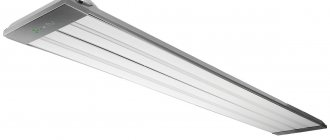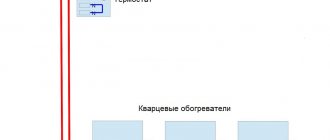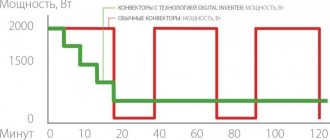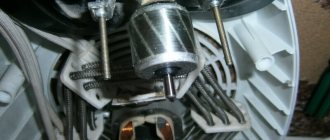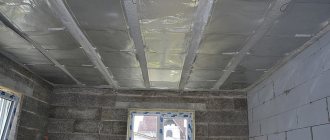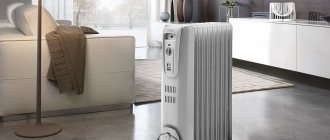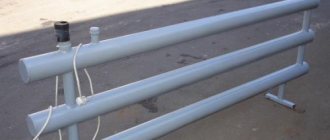Design and principle of operation
The design of the quartz heater is a monolithic body made of high quality molten quartz sand with the addition of marble chips, inside which a heating element in the form of a chromium-nickel spiral is laid. Current passes through the spiral, thereby heating it. The operating temperature of the heating coil is 980°C, but during operation of the heater it only heats up to 120°C. Low heating temperature allows you to extend the service life of the heating element.
Delivery set of TepplEko company
The body is highly inert, so the device takes a long time to heat up and takes a long time to cool down. This has both a positive side (even in the event of a power outage, the devices will still be able to give off heat to the premises for some time (about 1.5 hours after the shutdown)), and a negative side (if quick heating of the room is required, a quartz wall heater is unlikely to cope with this task , it takes 20-25 minutes to heat up to a temperature of +95°C).
The operating principle of a quartz heater is similar to the functioning of a Russian stove, which accumulates thermal energy and constantly releases it to the room. This effect is achieved thanks to the properties of quartz sand.
Thanks to the design of the device, natural convection occurs: cooled air is drawn into the space between the heater and the wall, where it is heated, rises to the top and exits at the top of the device.
When choosing any electric heating device, one of the main criteria is safety. A quartz heater is a fireproof device. This is achieved by the fact that the heater is located inside the device and does not come into contact with air. In addition, the device does not heat above +95°C, this is not enough for the body to begin to melt, because... The melting temperature of quartz sand is about 1700-1728°C (due to high internal friction it is difficult to determine the exact figure, but even the minimum temperature is not enough to start the melting process). In addition, each manufacturer produces protective grilles, which eliminate the possibility of accidentally getting burned.
The protective grille prevents accidental burns. This accessory becomes especially relevant if there are small children in the house. Its cost is 1100 rubles/unit.
How the device works
Using a nichrome spiral, the surface of the monolithic slab is heated to a high temperature (+95°C). At the same time, infrared radiation is generated. At the same time, convective heating of the air occurs, that is, the cold flow enters the lower part of the device, heats up and exits already warmed up through the top. The cooled air then settles and the process repeats.
Based on the principle of operation of the heater, we can say that the monolithic device works both as an infrared heater and as a convector heater.
Attention! The stove is not equipped with automation, so it constantly works at maximum. To regulate the temperature, you need to additionally purchase an external thermostat and connect a heater through it.
A quartz monolith can be used both as an auxiliary device and as a main one. For a large room area, a system of several modules with a parallel connection is assembled.
The number of devices needed to heat a room depends entirely on its area and possible heat loss. If the house is insulated, then in a room measuring 12 m² it is enough to install two quartz monolithic heaters to maintain normal temperature at a constant level. When several devices are installed in one room, a common thermostat is installed to regulate the temperature, which also saves energy. You can install a monolithic heater yourself. The stove is attached to the wall using brackets, and placed on the floor on a special stand.
About the disadvantages and advantages
Since our task is to determine the real pros and cons of quartz heaters, we will not repeat the advertising statements of manufacturers, but will highlight the negative and positive aspects based on user responses. Let's start with monolithic batteries, whose advantages are as follows:
- affordable price of products (from 40 USD);
- the device does not create noise during operation;
- the most simple design, where the parts are embedded deep into the slab, allows you to reduce the maintenance of the product to cleaning from dust;
- the product is environmentally friendly, as it is made from natural materials;
- heaters, correctly selected in terms of power and quantity, warm up the room quite quickly thanks to two heat transfer paths - infrared radiation and convection.
Different textures and colors of the front panel of the quartz heater
Unfortunately, a solid list of advantages of monolithic heating devices is offset by a list of disadvantages:
- Decent weight, like a small cast iron radiator. When placing on the wall, you will need a reliable mount.
- The fragility of the slabs, often cracking and breaking into pieces even at the transportation stage. Also, cracks appear after the first switching on and warming up of the stove.
- The unattractive design and unsightly appearance immediately make it clear that this is a budget product.
- The heater cannot simply be plugged in, otherwise it will constantly and uncontrollably “plow” at full power. You need to buy a thermostat for a separate fee and connect it to an electric battery.
- Too high a surface temperature (95 °C) can cause burns, which is especially dangerous for small children. Again, you need to invest in a protective screen.
If the heater looks good from the front, the rough stand and rear panel spoil the impression
A separate issue is the quality of manufacturing of quartz heaters for a home or apartment, which is clearly visible on the back side of the stove (shown in the photo). According to reviews, users often receive products with peeling paint, cracks, or no sockets included, which does not add to its popularity. But the worst thing is when an electric heater connected to the network produces an electric shock when accidentally touched (there are also such things). This makes it dangerous for all residents and even pets.
Beautiful ceramic heater – picture
Infrared tubular devices also do not make noise during operation (sometimes they crackle slightly), but their design is more advanced than that of heating plates. This is expressed by the following advantages:
- instant heating of surfaces, bypassing the air;
- safety in operation;
- light weight and mobility;
- presence of a built-in thermostat;
- attractive design;
- acceptable sizes;
- wide selection of models and brands.
The choice of infrared quartz heaters is very wide
Heating element design
Convectors from almost all manufacturers have a similar heating element, which is based on an incandescent filament. This can be a tungsten filament (the most durable and efficient in terms of heat generation), nichrome (cheaper, less durable and effective) or steel (the simplest, bulkiest and has the shortest service life).
Steel spirals are practically not used in convectors due to their bulkiness, but can be used in other devices. The first two types, on the contrary, are widely used in the production of convectors, and regardless of the material of the heating coil, the technical documentation indicates that the material is tungsten.
It is impossible for the average person to distinguish one material from another without special laboratory instruments, which is what sellers use. But there is still one indirect sign. This is the service life and warranty period of the heater. Since tungsten is a very refractory material, it has a much longer service life as a heating element than nichrome. Modern NOBO electric convectors, which use tungsten filament, have a warranty period of 10 and sometimes 12 years, and a service life of 30 years. A nichrome spiral will not work that long.
Leaving the filament open to contact with air guarantees the effect of “burning oxygen,” and the high temperature of the filament will ensure rapid “drying of the air.” To avoid this, the filament is placed in a tube. The space between the tube and the thread is filled with quartz sand. To increase heat transfer from such a heating element, the tube itself is made into a single stamped or solid piece with fins. It is the fins that provide a larger area of heat exchange between the electric heater and the air and, accordingly, faster heating of the room.
In the photo: Design of the heating element of the Nobo convector
The one-piece design of the tube and fins completely eliminates cracking due to linear expansion of the metal during heating and cooling. Aluminum alloys are used as materials for these elements as they are the most efficient in terms of heat transfer.
The design of the heating element is not always solid. Often, for reasons of economy, a tube is used from one material, and fins from another. Different linear expansions of materials often lead to their movement relative to each other, which can cause slight crackling sounds.
The heating element of quartz heaters is designed somewhat differently. Most often, a nichrome filament is also used in its manufacture. Under the influence of electric current, it heats up, increasing the temperature of the heater body. Moreover, the heating element is located over the entire surface of the device and there may be a small air gap between them.
The body of such a heater is made of quartz. Considering the principle of operation, the entire design of the device can be called a heating element. Any device that heats up as an electric current passes through it can be used as a heating element. Thus, there are quartz heaters where an IR emitter is used as a heating element, which heats the intermediate surface using infrared rays. This could be the outer casing of the heater or any reflective surface that heats the air. For this reason, such a heater can also be called infrared, since the principle of its operation is based on infrared radiation.
In the photo: Heating element of quartz heaters
Classification of heating devices
There are a huge number of homemade heaters. You can make them from scrap materials. Many craftsmen are trying their best. Because of this, structures often appear that become the causes of great troubles. Before starting work, a wise owner will think about safety.
Despite their diversity, all devices are divided into certain groups according to their main technical characteristics.
Here is a list of their differences:
Oil and water. The battery filled with heated liquid is still the most common type of heater due to its relative safety and reliability.
Electric fireplaces. Appliances with an open element for heating air. One of the most dangerous types of such devices. Fires, burns, and electric shock are the main problems that arise from an improperly made or operated device of this type.
Fan heaters. The principle of the heater is the same as in the previous version, only here the air is supplied to the room by a special fan built into the device. Very convenient for quickly heating a specific area.
Thermal panels. The safest and most reliable type of homemade heaters. It’s very easy to make from ready-made infrared panels. Some people dare to independently make such panels from scrap materials.
Fiery. Heaters that use open fire. Very rarely used at home, but popular for fishing, camping, for heating sheds and garages
It goes without saying that with this type of heating, increased attention is paid to compliance with fire safety rules.

Types of heaters for home use
When choosing the design of a future device, it is important to pay attention not only to its safety, but also to its efficiency. Therefore, they first determine what requirements and purposes the future heater must meet.
Here are some criteria for such an assessment:
- safety;
- productivity;
- efficiency;
- ease of assembly and maintenance;
- compactness;
- convenience;
- efficiency.
In that video you will learn how to make a catalytic heater;
Cheap options for quartz heating batteries
It is worth mentioning separately about budget options for radiators with quartz sand. They can be recognized by their appearance - the decorative coating is of poor quality, the paint on the back is peeling, and the frame around the perimeter is made with gaps.
Such quartz heating batteries are often not fully equipped - they may lack a plug for connecting to the network, brackets, or a stand. Nichrome thread burns out over time, which is why the service life is no more than 5 years. Electrical breakdowns are possible and can cause a short circuit.
Despite being a new technology, quartz radiators are gaining popularity. They cannot be called economical or energy-saving, but such heating devices have a right to life. We hope that the publication was useful to you. Don't forget to share it with your friends!
Infrared heaters
Principle and features of work
An infrared heater is a metal or plastic case, inside of which there are glass tubes with nichrome or tungsten spirals. The housing on one side is completely open or made transparent so that infrared radiation from the spirals is transmitted into the room. The tubes are filled with inert gas, which increases operational safety and protects against dust getting on the coils and extends their service life. Behind the tubes there is a mirror reflector that directs all radiation in one direction.
Diagram of an infrared heater
The operation of the electric heater is controlled by the control panel according to the following algorithm:
- After turning on the heater, the tungsten filament heats up and begins to emit heat, which the reflector directs towards the heated room.
- All surfaces that receive infrared radiation from the device heat up and begin to warm the air that is next to them.
- After the room temperature rises to a preset limit, the built-in thermostat turns off the heater.
- After the air cools slightly (by 2-3 degrees), the thermostat turns on the device again and the cycle repeats.
Infrared heaters are absolutely safe to use
Advantages and disadvantages
The main advantages of infrared devices include the following:
- quick heating of rooms;
- uniform temperature distribution in the room along the height;
- silent operation due to the absence of moving parts;
- high environmental friendliness - do not emit harmful substances;
- do not burn oxygen in the room;
- ease of installation and operation;
- high reliability and long service life.
The disadvantages of these models include the following factors:
- prolonged exposure to a person causes discomfort;
- high energy costs;
- heating home furnishings causes them to accelerate aging or become overheated;
- During operation, the emitters glow red, which may cause discomfort when used at night.
The varied design of infrared heaters makes it easy to match them to the design of the room
Popular models of IR heaters for summer cottages
Several years ago, the choice of heater brand was limited to a few models manufactured in the EU. Currently, the following companies offer equipment on the climate control market:
- Europe and Asia (without China): UFO,
Infra,
Heliosa,
Hyundai
Zilon,
Starprogetti.
Floor and ceiling infrared heaters for heating country houses of these brands have a long service life, high performance and almost flawless control.
Russia:
- PEONY,
EcoLine,
Mister Hit,
IcoLine.
Domestic models have an acceptable cost and are fully adapted to our operating conditions. Russian gas heaters are equipped with a special reducer that allows you to connect both bottled and main gas. An additional security sensor has been installed. It is allowed to use the installation for heating a wooden cottage.
Chinese brands - budget models do not differ in build quality. It is not recommended to use Chinese devices in constant operation.
The choice of heater brand depends on the economic capabilities and operating characteristics of the device. If you plan to use the emitter for continuous use, you should not purchase cheap, low-quality models.
Varieties
Convectors have many varieties, which differ:
- by type of coolant (electric, gas, water);
- by type of operation (convection, infrared or mixed type);
- by installation method (floor, wall, ceiling, baseboard);
- by material of manufacture (steel, ceramic, glass, quartz);
- according to additional options (with natural convection or forced with a fan, with an ionizer or humidifier, with a dust filter and others).
When choosing a convector for your dacha or home, you should also remember about the different power of the devices. Preference should be given to one type or another based on the volume of heated air in the room. Manufacturers usually indicate the maximum number of square meters for which the device is designed.
If, for example, the room is poorly insulated, there are drafts, the windows face north, or there are other conditions that contribute to a decrease in temperature and heat loss, you should choose a convector of higher power. So, for a room of 15-20 square meters, purchase a heating device with a power of at least 2 kW. A 1 kW device can heat a very small room of up to 12 square meters. If the convector has additional options (air humidification, electronic thermoregulation), then it is worth taking into account these losses when operating the device. Accordingly, it will fit an area smaller than the declared one by about 30-40%.
Infrared
These are the most modern innovative models. Their effectiveness is increased due to the additional effect of infrared radiation. Combined type devices have 2 heating elements and can operate even if one of them fails.
They have increased efficiency and warm up the room faster than other types due to the transfer of heat by IR waves to surrounding objects. Such devices often have decorative panels and are the latest generation heating systems.
Electrical
Electric convectors work by heating the internal element (heating element) with electric current. Using such a device is absolutely safe. The heating element is protected by the insulation and shell of the convector, so at any set temperature its surface does not heat up above 50-60 degrees.
They are equipped with automatic thermostats. It is worth remembering that an electric convector consumes a sufficient amount of energy. Therefore, you need to choose the option with maximum energy saving. It is suitable for a small room or intermittent operation (between heating seasons).
Gas
The gas convector is not very popular, although it was originally designed as a more economical alternative to the electric one. It runs on liquefied gas from a cylinder. It is also convenient to use it in private households if it is possible to connect to the highway. At the same time, its installation should be carefully considered, since further dismantling and transfer of the device may cause difficulties.
In addition, a gas convector requires a flue gas removal and recovery system. Installing such a convector will require special skills. And the savings become relative, since significant heat losses will occur through ventilation to remove gases in the outer wall.
Mermen
Convectors with water as a coolant are characterized by maximum efficiency, ease of use and safety.
Water intake for heating comes from the centralized heating system. They are compact and can be hidden under the floor surface (so-called “plinth models”). Their only drawback is the small area of the heated room. It should not exceed 10-12 square meters.
Comments:
Rodion
Good review, although I didn’t notice any special features of this type of heater. I installed both convectors and quartz ones - the electricity consumption is almost the same. The only difference is the price.
Jack
Rodion, I don’t know about you, but I feel the difference. Quartz is much heavier and produces 20 percent more heat at the same electricity costs
TeplopitBel
The patent for the Quartz electric heater belongs only to the manufacturer from Belarus - TeplopitBel. https://teplopit.bel This is how TeplopitBel-Belarus differs from its Russian counterparts. 1. Electricity consumption of TeplopitBel (250 W/hour) is 1.5 times less than that of Russian ones. 2. Heat transfer is 1.5 times greater than that of Russian ones (due to the composition of the purest quartz sand). 3. The radiating surface area is 1.5 times larger due to the coating with natural material (natural mountain stone). 4. Cools down 30% slower in time (after complete shutdown) due to the increased area of the radiating surface. 5. Heats a room twice as large with an area of 10-12 sq.m. in contrast to the Russian analogue (5 sq.m). 6. The appearance of the heater does not require a decorative screen. The savings are double at the same price. https://teplopit.bel
Alex
Don't take JUNK FROM CLOWNS WITH TEPLEKO SEE OUR BELARUSIAN Quartz heater with Patent and documents
Stepan from St. Petersburg
Tepleko is produced in Kemerovo by individual entrepreneur Kotenkov (type all the information on the Internet) Here they are, factory ones with short wires without a plug, selling them to TD TEPLEKO on a simplified single tax - distribution and difference trade. And there's not even a cash register. Not provided due to low turnover.
And that’s what they have a Patent for on an electric heater... For water or for what??? And where is the Patent for the Quartz heater... SHOW. If there is no Patent (for a Quartz heater), don’t write that you are producing them. Or don’t screw up everyone who makes analogues.
THE COOL FACTORY Tepleko DOESN'T EVEN HAVE A CASH REGISTER - ONLY A SINGLE TAX!!! Like our entrepreneurs at the market in the Republic of Belarus (only ours even have a cash register). Like delivering pizza to apartments. They are always on PROMOTION. There is no receipt and no guarantee as for PROMOTIONS. They are registered as delivery and differential trade. Laughter for a cool company. Now it is clear that their products correspond to their level. Total self-promotion. LIKE ? TAKE IT.
Rodion SPB
The patent for the Quartz electric heater belongs only to the manufacturer from Belarus - TeplopitBel. https://teplopit.bel This is how TeplopitBel-Belarus differs from its Russian counterparts. 1. Electricity consumption of TeplopitBel (250 W/hour) is 1.5 times less than that of Russian ones. 2. Heat transfer is 1.5 times greater than that of Russian ones (due to the composition of the purest quartz sand). 3. The radiating surface area is 1.5 times larger due to the coating with natural material (natural mountain stone). 4. Cools down 30% slower in time (after complete shutdown) due to the increased area of the emitting surface. 5. Heats a room twice as large with an area of 10-12 sq.m. in contrast to the Russian analogue (5 sq.m). 6. The appearance of the heater does not require a decorative screen. The savings are double for the same price. https://teplopit.bel
Valentina
People, be vigilant, avoid this sharazhka's office! For them, the customer is always wrong; after the acquisition, you are enemy No. 1 for them! I learned this the hard way, the website says a 3-year warranty, but I purchased it a month and a half ago and it turns out that for some reason this warranty does not apply to me! All the good reviews are written by the company employees themselves, they are hired there specifically for this purpose, it is IMPOSSIBLE to leave a bad review on their website, they call back and start threatening!…
tadgikovfup
Individual cottages are not connected to the main heating organization; for this reason, they request installation of independent heating. The core component of your own heating network is undoubtedly the boiler, which heats the coolant. There are quite a lot of models of this type of equipment on sale, which seriously complicates the choice. It is very important to approach the process of purchasing a boiler wisely, since this is the only way to design your home to be warm and cozy. Let's look at some likely options!
drip irrigation in a greenhouse
Sergey Petrovich
But having purchased Tepleko, you need to immediately take care of concluding an installation agreement with an organization that has the 3rd approval for the installation of electrical appliances. Otherwise there will be no guarantee. Yes, Tepleko also has promotions all year round. Promotional items are not subject to warranty anyway. We played it safe. So get ready to immediately purchase from Tepleko a non-warranty product that can be used with cracks (written in the passport). Who gave them the Certificate? It is not clear how such offices generally work. Tepleko is a Lego constructor and a circle of skillful hands.
Valentina
For example, if you bought from Tepleko, then you also need to invite a company to connect and draw up an Acceptance Certificate for connecting the Tepleko heater (this service is not cheap - like the heater itself). Otherwise there is no guarantee. That's it gentlemen!!! And Tepleko has a promotion for a whole year. This means that in any case (even with an official connection) you have no guarantee. There is no guarantee on the Promotion. This is how, gentlemen, it turns out to be twice as expensive to buy Tepleko. You also need to additionally buy a plug and screw it yourself, mounts and a reflector on the wall. Total price is 2700 from Tepleko. And TeplopitBel sells its heaters (in bulk) twice as economically for 1,800 rubles. Here's the schedule for you. One TeplopitBel warms like two Tepleko. And in terms of area, TeplopitBel is designed for 10-12 sq.m. and Tepleko for 5 sq.m.
Anatoly
Tepleko-RF has a lot of shortcomings. That's why. Write to yourself. First of all, this is the most important thing. Tepleko does not have a Patent for a Quartz heater (Tepleko has a Patent for an Electric Heater) - You are misleading buyers. The patent for a quartz heater is only available from TeplopitBel from Minsk. Secondly, you add marble chips yourself (all this is written on your old website), and this reduces the thermal conductivity of the heaters. Further more…. — Tepleko consumes 20% more than stated (measure the resistance). — Operation with cracks (written in the passport) is just crazy (How did you get the Certificate???). - Lack of any guarantee (written in the passport - connection only through a company with an additional payment). Buyers don't know this yet. — Cable 50cm. without a plug (Who issued you a Certificate for the electrical device???) - Lack of a plug on the cable (you have to buy it and screw it yourself???). — Additionally, buy brackets and a reflector. — Cracks in 99%. — Heating area 5 square meters. — Lack of stores with real purchases and selection on site (only through mail via the online store). Whatever comes in the mail cannot be returned. Maybe it’s enough to list? Or maybe a dozen more.
Kirill
Just recently I bought myself a Tepleko heater, so overall the heater is 5 out of 5, it’s just perfect, there are some small nuances but they don’t affect anything, because the heater heats up very quickly, now my room sometimes turns into a bathhouse so I have to turn it off and even open the window, in general I need to buy another thermostat in order to sleep comfortably.
Heater TeplopitBel
Energy-saving Quartz heater TeplopitBel with built-in thermostat for heating
TeplopitBel quartz heaters are made of quartz sand. Energy-saving convectors are suitable for heating all premises: gymnasiums, shops, offices, apartments, houses, restaurants, garages, universities, gymnasiums, schools, sanatoriums, kindergartens.
The heating element of the TeplopitBel monolithic plate consists of an alloy of chromium and nickel. It is sealed so that air does not penetrate to it. Therefore, it can easily withstand high temperatures.
TeplopitBel is a unique device. It does not create noise, does not generate dust, does not dry out the air in the room, and concentrates slow cooling and rapid heating.
We recommend installing energy-saving convectors parallel to each other in order to significantly increase the activity and quality of their work. If you decide to purchase a thermostat, it is better that it is located between the heating devices. The thermostat helps save electricity and stabilizes the temperature of electric heaters.
TeplopitBel is easily mounted on walls using several fasteners. We do not recommend pressing the unit very tightly against the wall, as this will certainly lead to a significant decrease in efficiency levels.
Advantages of heating units: reliability, durability, fire resistance, provision of a comfortable microclimate, frost resistance.
Before installing the electric battery, it is worth preparing it by measuring two centimeters between the heat device and the wall on which the installation will be carried out.
The temperature regime of an energy-saving convector can be regulated much more quickly using a thermostat. How to use a temperature sensor? Set any temperature on it. When this device “decides” that there is as much heat in the room as needed, it will turn off on its own.
A modern heat and power generator, decorated with attractive embossing, created according to a special recipe. You can choose any of 3 models: with a consumption of three hundred watts per hour, two hundred fifty watts per hour, four hundred watts per hour.
The cost of a quartz heater, which was created in Belarus, will please every buyer. Anyone who is outraged by the price of a wall-mounted unit, know that it is fairly compensated by reliability, high quality and beautiful design. Regular customers are guaranteed a nice discount! Come, choose and buy! We are sincerely glad to see every visitor!
Leave a comment Cancel reply
Related Posts
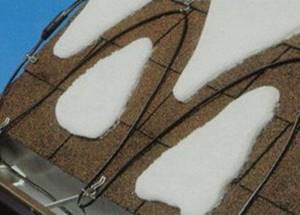
Heating the roof will help avoid problems with melting snow.
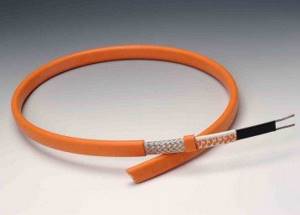
Selecting a heating cable for heating a water pipe
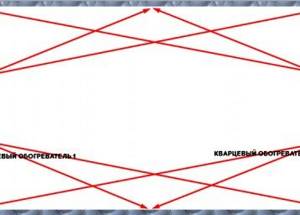
We heat a private house using electric heating
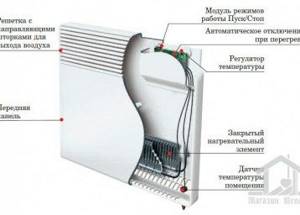
An electric convector on the wall will quickly warm up the room
Cost-effectiveness of quartz heaters
The next myth is about the financial feasibility of using these devices. High electricity tariffs and prices for household appliances cast doubt on the purchase of a quartz-based device. First, let's look at the average price of heaters.
Monolithic devices are made of inexpensive materials, for this reason the market price is quite low compared to many other types of devices. The price of infrared models is slightly higher than that of monolithic ones, which is due to more expensive materials.
In addition to the price of the device, you need to take into account the electricity consumption. For a monolithic heater it is 2.54 kW per day when using a thermostat. Infrared consumption is slightly higher - 8 kW per day, also when using a thermostat. Thus, the energy consumption will not be too high per month even in conditions of constant operation of the device. Given the efficiency of 98%, energy consumption will only be used to produce heat. In this case, unnecessary waste of energy is practically eliminated.
Based on the above facts, it can be argued that the use of quartz heaters is beneficial from an economic point of view.
Which heater is better - recommendations for choosing
If you find it difficult to choose between a monolithic and infrared heating device, then read our recommendations on this matter:
- When installing permanent electric heating in a private house or country house, it is better to buy stationary quartz heaters in the form of stoves. One condition: the products must be in harmony with the interior, otherwise you should think about another heating method.
- For local and temporary heating of people in any premises and outdoors, a quartz heater of the UFO type is perfect.
- The best way to use monolithic panels is in combination with other heating systems. For example, during the day the house is heated by a stove or boiler, and at night - by quartz heaters, and even at a cheap rate.
- Do not rely on infrared heating as the main method of heating a country house or country house where you visit. While the infrared devices warm up the building well, you will have time to finish your business and head back.
- Regardless of the type of quartz heater, select the right devices based on power. Do not believe or think that one 400 W stove will provide heat in a 10 m² room at a frost of -5 ° C and below. She barely has enough “strength” to slightly raise the temperature and prevent you from freezing.
Heating with several panels together with water radiators (standing behind the screens)
One of the main recommendations is not to believe numerous advertising statements of this kind:
- our panel heats up in 20 minutes and cools down for an hour, continuously releasing heat;
- our heater is 30-50% more economical than others;
- a 500 W device is enough to heat a room of 10-12 m² (in reality - no more than 7 m²);
- Our heater generates no more than 2.5 kW of electricity per day, and it’s hot in the apartment!
Counting example. For a room of 10 m² with a ceiling height of 2.7 m, on the coldest days you will need 10 x 2.7 x 40 = 1100 W of heat (that is, the same amount of electricity). In this situation, 2 monolithic heaters of 400 W each will work without interruption, wind up 0.8 x 24 = 19 kW per day and will not reach a comfortable temperature. But even if we take not the maximum, but the average heat consumption for the season and divide 1100 W in half, then we will have to spend 550 x 24 = 13200 W = 13.2 kW of heat per day on heating, no matter how you look at it.
It is too expensive to heat large rooms with quartz appliances, unless you arrange local heating
Manufacturers and model overview
Currently, the heating appliance market offers models of quartz heaters not only from Russia, but also from Europe. The most popular manufacturers are:
- "Thermoquartz";
- "Exo";
- "Prometheus";
- "Texture";
- "WarmHoff";
- "Equation"
Let's consider the most popular models of monolithic quartz devices.
"TeploplitBel"
The model is produced for installation in bathrooms, as this device is not afraid of moisture. The heater allows you to heat small bathrooms and toilet rooms without using stationary heating. This can be relevant not only in private houses, but also in cold corner apartments in panel houses.
The power of this quartz heater is only 0.25 kW. This is very little (that’s how much two incandescent lamps consume), which means that the device can be left running constantly without fear of a significant increase in electricity bills.
The advantages of the model include:
- the ability to choose a decorative panel to match the color and design of the walls in the room;
- optimal panel thickness (2.5 cm) takes a long time to cool down after switching off;
- reaches maximum operating temperature in 25 minutes;
- small sizes – 60x34 cm;
- operates smoothly even with voltage surges from 207 to 250 Volts;
- optimally suited for rooms up to 10 square meters with a ceiling height of no more than 3 meters.
The disadvantages of this model include the weight - it is 11 kilograms, and the absence of a regulator for the operation of the device.
"TepplEco"
This model is also recommended by the manufacturer for installation in bathrooms. Its rated power is only 400 watts, but this is enough to heat small bathrooms and provide a comfortable temperature there.
The quartz slab in TeplEko is placed in a metal frame, which is coated with powder paint. This allows you to protect the product body from corrosion under operating conditions with high humidity.
The advantages of the model include:
- beautiful appearance and interesting design;
- conveniently located power button on the side of the device;
- thin body – only 2.5 cm;
- continues to heat the room even after an hour and a half after being disconnected from the network;
- does not dry out the air;
- reaches operating temperature in 18-20 minutes;
- a well-insulated housing eliminates the possibility of moisture getting inside the heater;
- dimensions – 60x35 cm;
- Perfect for rooms up to 18 square meters.
The model has few disadvantages. Among them:
- no thermostat;
- the weight of one panel is about 12 kg, so they cannot be used for wall placement, especially on plasterboard walls.
"Improved heat stoves"
Recommended by the manufacturer as a heat source in corridors and spacious halls of country houses and apartments. A distinctive feature of this model is its design - the main color is replete with small black inclusions that imitate natural stone. This device will fit perfectly into any interior. This is an excellent option for heating a room when it is inconvenient to pull pipes into the corridor or they spoil the appearance of the room.
“Improved heat stoves” have the following advantages:
- The kit includes a 1.5 meter long wire and a plug for connecting to the mains;
- safe when used near upholstered furniture, textiles and soft toys;
- wide range of colors;
- cools down within 2 hours, continuing to heat the room all this time;
- does not burn oxygen and does not dry out the air;
- easy to install - it has only 3 points for fixation;
- capable of heating a room of 12-15 square meters;
- consumes only 0.4 kW per hour;
- The surface layer made of natural material prolongs the cooling time of the device, which makes it more economical.
The disadvantages include:
- a small manufacturer’s warranty - only 2 years from the date of start of operation;
- must be supplemented with a foil screen at the rear wall for more efficient operation;
- no thermostat;
- The weight of the panel is 10 kilograms, so when mounted on the wall it must be strong. Modern plasterboard walls simply cannot withstand such weight.
Installation and operating conditions
The maximum operating temperature reaches 95°C, while the average power consumption remains at 500 W. This power will be enough to heat 7-13 square meters. m.
Wall-mounted models are fixed to the surface using convenient brackets, the latter are usually included in the package. It is important to ensure that the weight of the device corresponds to the type of base material: the load-bearing capabilities of concrete, wood, lining, brick, and drywall vary.
Floor-standing variations only require an outlet, but when using them you need to keep an eye on children and pets and do not place textiles nearby.
Comparison with radiators and convectors
With electric convectors, 80-90% of the thermal energy is released by heating the air. And only 10-20% - through infrared radiation. They quickly begin to heat the air in the room, but the objects in it (furniture, walls, etc.) remain cold for a long time.
Conventional infrared convectors give off a lot of thermal energy through IR radiation. They warm up objects in the room well. But the air remains cold for a long time. Such devices are effective at maintaining temperature, not heating.
Oil heaters are more similar in characteristics to micathermic heaters. They give off quite a lot of heat due to infrared radiation. Although most of it goes to convection. Their disadvantage is the long heating of the oil in the housing.
Micathermic heaters are an average option. they quickly begin to warm up the room; due to relatively large convection, the air in it is not so cold. With the correct selection of the model, you can ensure comfortable heating of the room.
Advantages and disadvantages
Now we will look at the positive and negative traits. Since we are considering two types of this heating equipment at once, we will divide the article into two parts. First, let's look at the pros and cons of infrared models.
Infrared quartz heaters are characterized by the following positive features:
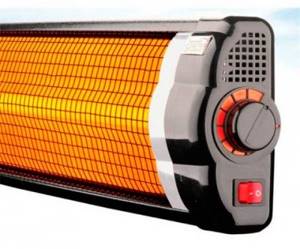
The glass tube in quartz IR heaters is both a plus and a minus. It is fragile, but protects the oxygen in the room from combustion.
- Compactness - they easily fit even under the table;
- Rapid heating of rooms – heat begins to be generated almost immediately;
- High efficiency - almost all electricity is transformed into heat;
- These devices do not burn oxygen - as we remember, the hot spiral is sealed in a sealed glass tube.
There were some downsides:
- Not a very presentable appearance - whatever you say, such devices still spoil the interiors of rooms and non-residential premises;
- Low safety - if children play in the room, you need to somehow protect the equipment from access (the child can get burned);
- Fragility - if the heating element accidentally breaks (and there is every chance of this), then it will be easier to throw away such a device than to repair it.
The shortcomings turned out to be serious, some of them cannot be ignored. You also need to protect your equipment from bumps and falls, otherwise it will be difficult to avoid its failure.
The most striking disadvantage is the high temperature of individual parts. Not only children, but also adults can get burned by it. And the outstanding advantage is mobility - these devices can easily be moved from place to place.
Energy-saving wall-mounted quartz heaters for home and garden can be called stationary heating equipment. They are attached to the walls and remain there throughout their entire service life. Let's look at the positive features:
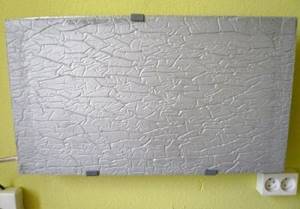
Wall-mounted monolithic models have a quite decent appearance, which distinguishes them from their infrared counterparts.
- Low case temperature – it does not exceed +95 degrees;
- Equipment safety - you will get burned only with the most intense heating. If small children are playing indoors, simply reduce the temperature;
- High heat capacity - the same devices from Tepleko and Teploplit can retain the accumulated thermal energy for an hour and a half;
- Impressive efficiency - one block warms 15-16 square meters. m, consuming 0.4-0.5 kW of electricity. For electric heating equipment these are amazing results;
- There is no effect on air parameters - the amount of oxygen and humidity do not change during operation of the equipment;
- The ability to work in the “anti-freeze” mode is an excellent opportunity to prevent your dacha or country house from freezing.
There are almost no disadvantages:
- Decent weight of the equipment - due to the use of quartz, one module weighs about 12 kg;
- Intense heating can cause burns - make sure that your children do not try to touch the interesting warm thing hanging on the wall.
Otherwise there are no shortcomings. Quartz monolithic heaters can work in absolutely any room, from rooms to a damp and always wet bathroom. They are easy to install and do not lead to huge energy costs. The limited power of the equipment causes some inconvenience, so to warm up a large area you should use several heaters - you won’t be able to find a more powerful model.
How to choose
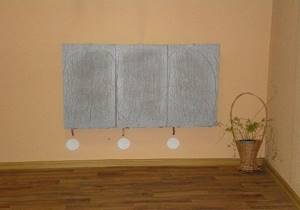
Heaters with a monolithic quartz slab are perfect for heating an apartment, country house or cottage.
Now we come to the most important question - how to choose and what to look for when buying heating equipment? There are no difficulties in this matter, you just need to decide under what conditions the equipment will be operated and how often it should work. The selection process is simple:
- If you need to solve the problem of periodic shutdowns of central heating or lack of heat, you should choose from infrared models;
- If you need to create an autonomous heating system, you need to purchase a monolithic quartz heater.
Infrared models are presented with samples with the widest power range ranging from 800 W to 2-3 kW. If there is a lack of heat, it is enough to purchase the lowest-power model. In all other cases, it is best to purchase monolithic heaters - for 15-16 square meters. m. area will require one module with a power of 0.4-0.5 kW. When choosing an infrared device, focus on the standard formula - 1 kW of power per 10 sq. m. area .
Infrared heaters will be the optimal choice for heating country houses, but only if the residents appear there occasionally and do not live there on a permanent basis.
Review of the best models
Is a quartz heater already warming your home?
Of course! No, but it will be!
Based on information from manufacturers and consumer reviews, we have compiled a review of 5 popular models of quartz heaters.
"TeppleEco" (Russia)
The only domestic manufacturer producing devices from highly purified quartz sand.
Main characteristics:
- Size – 60 x 35 x 2.5 cm.
- Weight – 12 kg.
- Power – 0.4 kW.
- Energy consumption – 2.5-3.5 kWh/day.
- Heated air volume (with minimal heat loss) – 18 m3
Pros:
Minuses:
"TeplopitBel" (Belarus)
The specificity of the devices is to increase the radiating surface due to processing with natural quartz chips. This technology is the property of the enterprise and has no analogues.
Main characteristics:
- Size – 61 x 34 x 2.5 cm.
- Weight – 11 kg.
- Power – 0.25 kW.
- Energy consumption – 0.25 kW/hour.
- Heated air volume (with minimal heat loss) – 14-16 m3
Pros:
Minuses:
- Many consumers note the poor quality of service.
- Difficulty installing additional equipment.
- In severe frosts it is ineffective.
- Fast failure.
- The crumbs may crumble when heated.
Stiebel Eltron IW 180 (Germany)
Main characteristics:
- Size – 14.5 x 53.5 x 8.5 cm.
- Weight – 1.55 kg.
- Heated air volume (with minimal heat loss) – 18 m3
- Power – 1.8 kW.
Pros:
Minus
Inconvenient to mount on the wall.
Ballu BIH-L-2.0
Main characteristics:
- Size – 74 x 18 x 9 cm.
- Weight – 3.5 kg.
- Power – 2 kW.
- Heated air volume (with minimal heat loss) – 20 m3
- Approximate cost – 3300 rubles.
Pros:
- Protection from dust and moisture.
- Overheat shutdown.
- Installs on the wall or floor.
- Equipped with a thermostat.
Minus
There is no possibility of power adjustment.
When choosing a quartz heater, you should not focus only on the cost of the device: taking into account the technical characteristics and your own needs will help you choose the right model.
Specifications
The standard dimensions of a quartz heater are 61 x 35 x 2.5 cm. The device weighs 10 kilograms. The device consumes power 0.5 kW. It takes 20 minutes for the device to be fully ready for use. At this time, the required heater temperature is reached - 95 degrees.
One quartz heater is capable of maintaining a comfortable temperature in a room area of about 8 square meters with a ceiling height of more than 3 meters.
Among the main advantages of quartz heaters are:
- Significant energy savings
- High heat capacity
- Innovative technologies
- Long service life
- Efficiency .
A quartz heater works especially effectively together with a thermostat, which is purchased separately. The thermostat monitors the heating device turning on and off, which eliminates the need to periodically turn the heating device on and off. You just need to set the maximum and minimum operating temperatures of the device on the thermostat. If the room temperature reaches the maximum setting, the heating device is disconnected from the network. It is very convenient to have separate thermostats in each room. They can be used to separately set room heating parameters. You just need to take care of the required quantity.
The use of a quartz heater in country houses is by far the most optimal solution to the issue of space heating. In a house with this device there will be no place for dampness, even if you are here no more than once a week, and do not constantly heat the house. You just need to set the temperature on the regulator to about 10 degrees. The next time you take the train out of town, you won’t feel the cold in the room. The house can be easily and quickly heated by increasing the temperature on the regulator.
The advantages of this heating method are obvious if there is no gas in the house, but you need to heat it somehow. You have to resort to either stove heating, electric heating or water heating. Not everyone decides to light a stove; heating with electricity is too expensive. But heating with water turns out to be the most wasteful. The costs of its arrangement are high, the price of consumables is high.
But if you use quartz heat sources, then the cost savings will be obvious; the price of a quartz heater is a completely solvable issue. You just need to purchase an additional thermostat.
The best quartz heaters for wall mounting
Stiebel Eltron IW 180
Weighs only 1.5 kg, it can be easily transported. Thanks to the peculiarities of the propagation of infrared rays, Stiebel Eltron IW 180 allows you to create locally heated zones even outdoors. Operates in three modes - 0.6/1.2/1.8 kW.
Advantages:
- Doesn't burn oxygen, no foreign odors, quiet.
- Reaches operating power in half a minute.
- The device is well protected even from heavy rain. Electrical safety class IW 180.
- Sudden power surges are tolerated normally.
- Three heating modes.
- Lightweight and reliable.
- Easily transportable.
- Using a specially designed tripod, you can place the heater at the angle of inclination (20-40 degrees) that is required.
- Effectively heats a space of 20 square meters. m.
Flaws:
The area heated by the device is limited. To be warm, you need to constantly be in the range of the device.
EWT Strato IR 106 S
Compared to other heaters, it is very small. Due to its light weight and well-thought-out design, the heater can be easily installed on the wall; a woman or even a pensioner can do this. Operates from a regular electrical network. Dimensions – 110x760x90 mm.
Pros:
- Easy. You can carry it or take it to the dacha without the slightest difficulty.
- The power of only 500 W allows you to save electricity.
- Doesn't burn oxygen from the air. It is not the object that heats up, but the objects in the radiation zone.
- Does not dry out the air.
- Simple and unpretentious during operation.
- Reliable.
- There is protection against high humidity.
- It turns off automatically when overheated.
Flaws:
- Effectively heats only 5 square meters. m. The power is very weak.
- Suitable for use in autumn and spring. To constantly heat the room in winter, it would be better to choose something more powerful.
TeploPlit
For dachas and apartments, such a heater, according to many reviews, is the most practical and optimal solution. Can be used as a main or auxiliary heating element. Combines infrared and converter heating methods.
Positive traits:
- Safe. The heating limit is 98 degrees. Nothing can catch fire at this temperature. Although the touch will be unpleasant.
- Long lasting. The service life has no restrictions. If you follow the operating rules, the device will work properly for decades.
- Reliable. There are no parts that could fail.
- No maintenance is required during operation.
- Withstands voltage surges up to 380 Volts.
- The heating element is reliably isolated from the surrounding air. Does not dry it out and does not burn oxygen.
- Efficiency approaches 98%.
- It works absolutely silently.
Negative sides:
Not found. An ideal device for its class. You can give first place in the ranking.
WarmHoff
Heaters from this company are known for their reliability and efficiency. They spend only 2.5 - 4 kW/h. They are very well protected from moisture and can be installed in the bathroom. If you follow the basic, most basic operating rules, it will last a long time. The design of the devices is such that electric shock is completely excluded.
Advantages:
- Saves electricity while effectively performing its tasks.
- Very quiet. Will not disturb your sleep at all.
- Does not dry out the air, does not burn oxygen in it and does not burn dust.
- Looks stylish. Will fit into any interior.
- Completely safe.
- It attaches quickly and without much difficulty.
- The desired temperature is easy to set and maintain.
- Effectively stores heat and releases it slowly. This allows you to periodically turn off the device.
- Affordable price.
Negative points:
According to most experts and users, there are none.
Appearance and structure of the device
The device looks quite simple - it is a thin monolithic slab about 25 mm wide. On the front side, as a decoration, a pattern is applied using embossing. Some manufacturers produce models with a smooth surface and in slight color variations. The stove is mounted on the wall, but if desired, it can also be installed on the floor. For this purpose, the kit includes special stands.
The inside of the heater is as simple as the outside - the heating element is represented by a spiral made of an alloy of nickel and chromium, which has good electrical insulation.

The manufacturing process of quartz heaters is also not particularly complicated. In production there are molds into which nichrome spirals and metal fittings are placed. All this is filled with a solution, most of which is quartz sand, and left until it hardens. Further drying of the slabs takes place using a special technology.
Distinctive features of a quartz monolithic heater:
- The device is small in size, but still works quite efficiently.
- It can be used to heat both residential and non-residential premises.
- The surface of the device heats up evenly. At any point the temperature will be the same.
- The heater operates autonomously.
- The neat and discreet design of the device allows it to seamlessly fit into the overall interior, and in some cases even become a decoration of the room.
How does a carbon-quartz heater work?
Operating principle of a carbon-quartz heater
Carbon-quartz devices are electric heaters that emit long infrared waves. The Russian stove works in a similar way, which in ancient times treated rheumatism and other ailments. Similar thermal radiation is used in medicine during physiotherapeutic procedures. Heating equipment is universal; it is installed in country houses and apartments, in country houses and in offices.
Heating device design
The electric heater is a double-sided stone panel, inside of which a carbon spiral is laid. Inside the case is quartz. The filler helps accumulate heat. Panels made of artificial stone have a thickness of 1.5-2.5 cm. Considering the dimensions of the product (up to 65 cm in length and up to 60 cm in height), this results in significant weight. There are models weighing 10-15 kg. The outer side of the panels is stylized as marble. The main part of the heaters is equipped with a temperature sensor. The device turns off current consumption when the set temperature is reached.
A special feature of the infrared carbon heater is the use of a carbon spiral. Carbon is a composite material that has a long service life. Unlike tungsten, it does not burn out during operation. A spiral is twisted from the fibers of the material. The power of the heating element depends on its length and thickness. When current passes, the spiral heats up and infrared radiation appears. The element transfers heat to the quartz filler and ceramic panels. They warm the room evenly.
Reviews from real users
Monolithic quartz heaters received the largest number of negative reviews, although there are also positive ones among them. If we discard fake responses, the average user rating is 3.5 on a five-point scale. Here are a few different examples:
Galina, Moscow.
I bought this “excellent” device for heating a small closed terrace at the dacha, the area is only 6.5 m2. At an outside temperature of +10 °C, the room took so long to warm up that I was tired of waiting; the heat was felt only 10 cm from the surface of the heater. In addition, when unpacking the product, I discovered that the paint was peeling off. Conclusion: the household appliance does not meet the declared characteristics.
Valery, Krasnodar.
We were looking for a suitable heater for the children's room, went through a lot of options and came across a quartz one. We decided to buy it, since the price is reasonable. In essence: the device heats well and holds heat for quite a long time, but at the same time it gives an electric shock and gets very hot, you can’t touch it. How to put it in the nursery? We called the company, they advised us to use a protective screen, and again costs. Considering the unpresentable appearance of the heater, the overall rating is a stretch of four.
Vera, Mezhdurechensk.
We bought a quartz heater to test for one of the rooms in a private house. It is far away, so the heat from the stove flows there poorly. Installed, connected, tested and were satisfied. Now you can sleep in this room and not freeze. Although it is unknown how the heater would cope alone, without a stove. To check, you need to cool down the house, but you don’t want that. I'm thinking of putting another one in the hallway.

Infrared devices can be used for heating outdoors
For reference. You can read more reviews and truthful assessments about quartz heaters on the pages of the well-known forum.
Often negative responses are caused by excessive trust in advertising and increased demands for a product in the budget price category. The second point is the unsuccessful selection of power based on savings, which again are promised by advertising. It is advisable to find out as much reliable information about the product as possible before purchasing. The most famous manufacturers of quartz heaters:
- TeplEco, St. Petersburg (RF);
- TeploPlit, St. Petersburg (RF);
- Texture, Nizhny Novgorod (RF);
- Teplopit (Republic of Belarus);
- Heat Center (Ukraine).
